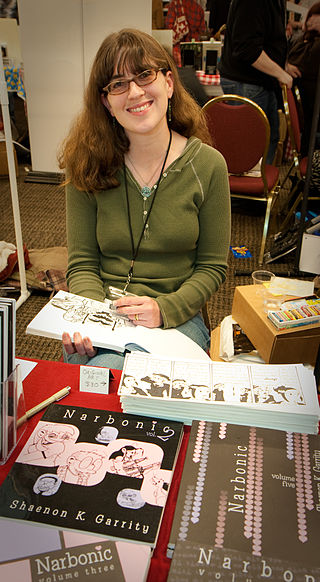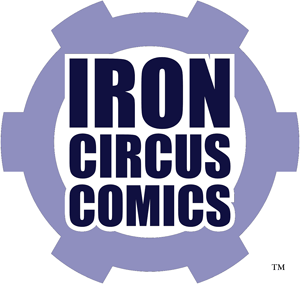Webcomics are comics published on the internet, such a on a website or a mobile app. While many webcomics are published exclusively online, others are also published in magazines, newspapers, or comic books.

Fetus-X was a weekly romantic horror comic written and drawn by Eric Millikin and Casey Sorrow. Millikin is an American artist and former human anatomy lab embalmer and dissectionist. Sorrow is an internationally known American illustrator and printmaker.
Serializer.net was a webcomic subscription service and artist collective published by Joey Manley and edited by Tom Hart and Eric Millikin that existed from 2002 to 2013. Designed to showcase artistic alternative webcomics using the unique nature of the medium, the works on Serializer.net were described by critics as "high art" and "avant-garde". The project became mostly inactive in 2007 and closed alongside Manley's other websites in 2013.

Real Life is an American webcomic drawn and authored by Maelyn Dean. It began on November 15, 1999, and is still updated, after breaks from December 10, 2015, to September 10, 2018, and again from July 16, 2019, to June 15, 2020. The comic is loosely based around the lives of fictionalized versions of Dean and her friends, including verbatim conversations, as well as fictional aspects including time travel and mecha combat. Characters regularly break the fourth wall. Real Life focuses on humor related to video games and science fiction, and references internet memes.

VG Cats is a webcomic written and drawn by Canadian cartoonist Scott Ramsoomair. Published on its own website, it follows the adventures of a pair of anthropomorphic cats, who often played the roles of characters in popular video games that are parodied in the strip.

Shaenon K. Garrity is a webcomic creator and science-fiction author best known for her webcomics Narbonic and Skin Horse. She collaborated with various artists to write webcomics for the Modern Tales-family of webcomic subscription services in the early 2000s, and write columns for various comics journals. Since 2003, Garrity has done freelance editing for Viz Media on various manga translations.

Demonology 101 is a webcomic written and drawn by Faith Erin Hicks from August 1999 to June 2004. It tells the story of Raven, a 16-year-old demon being raised by a human in ordinary human society. Hicks' first public work gained attention as an early story-focused webcomic, and ran for 700 pages before being concluded.

Jeffrey J. Rowland is the author and artist responsible for Wigu and Overcompensating, two popular webcomics. Originally from Locust Grove, Oklahoma, Rowland now lives in Easthampton, Massachusetts, where he continues to work on the two projects, while running TopatoCo, a company which sells merchandise based on his and other artists' comics.
Girlamatic was a webcomic subscription service launched by Joey Manley and Lea Hernandez in March 2003. It was the third online magazine Manley established as part of his Modern Tales family of websites. Girlamatic was created as a place where both female artists and readers could feel comfortable and featured a diverse mix of genres. When the site launched, the most recent webcomic pages and strips were free, and the website's archives were available by subscription. The editorial role was held by Hernandez from 2003 until 2006, when it was taken over by Arcana Jayne-creator Lisa Jonté, one of the site's original artists. In 2009, Girlamatic was relaunched as a free digital magazine, this time edited by Spades-creator Diana McQueen. The archives of the webcomics that ran on Girlamatic remained freely available until the website was discontinued in 2013.
Ugly Hill was a webcomic written and drawn by Paul Southworth. The titular "Ugly Hill" is the home town of its main characters. The webcomic has had several guest authors/artists, such as Howard Tayler of Schlock Mercenary and Kristofer Straub of Starslip Crisis. Ugly Hill has been lauded by the Web Cartoonists' Choice Awards for its character design.

Nowhere Girl is an adult fiction webcomic by Justine Shaw, about a "college student who feels like an outsider in her own life, finding her place in the world and coming to terms with her sexuality". It is named after a song written by British futurist band B-Movie. Since its start in 2001, Nowhere Girl has won several awards. However, the comic has been retired in 2010.

Dresden Codak is a webcomic written and illustrated by A. Senna Diaz. Described by Diaz as a "celebration of science, death and human folly", the comic presents stories that deal with elements of philosophy, science and technology, and/or psychology. The comic was recognized in 2008 at the Web Cartoonist's Choice Awards for Outstanding Use of Color and Outstanding Use of The Medium.
The Web Cartoonists' Choice Awards (WCCA) were annual awards in which established webcartoonists nominated and selected outstanding webcomics. The awards were held between 2001 and 2008, were mentioned in a New York Times column on webcomics in 2005, and have been mentioned as a tool for librarians.
Pictures for Sad Children is a 2007 webcomic, created by Simone Veil. The webcomic, about a ghost named Paul, featured a spare and minimalist black-and-white artstyle and depressive, nihilistic themes. In 2012, Veil launched a highly successful Kickstarter campaign to publish a print collection of the webcomic. However, Veil was not able to ship all of the copies to backers, and emails from fans asking when their book would arrive eventually led Veil to burn a portion of the remaining books. After Pictures for Sad Children was taken offline in 2014, a fan community rose up to share pages and other content from the webcomic.

Charlie Spike Trotman also known as C. Spike Trotman, is an American cartoonist and publisher known for creating the long-running web comic Templar, Arizona, and for publishing the Smut Peddler anthologies of what she describes as "lady centric porn". She is the founder and owner of Iron Circus Comics, an indie comics publisher which Forbes described as "a powerhouse of the indy landscape."
Notable events of 2002 in webcomics.
Notable events of 2004 in webcomics.
Notable events of 2005 in webcomics.

Iron Circus Comics is an American graphic novel publisher founded in 2007 by C. Spike Trotman. Based in Chicago, it is known for publishing the Smut Peddler line of "lady-centric porn" anthologies and graphic novels, and for its pioneering use of crowd-funding sites such as Kickstarter to finance graphic novel publishing, raising over $1 million in revenue through the platform in its first decade.
The business of webcomics involves creators earning a living through their webcomic, often using a variety of revenue channels. Those channels may include selling merchandise such as t-shirts, jackets, sweatpants, hats, pins, stickers, and toys, based on their work. Some also choose to sell print versions or compilations of their webcomics. Many webcomic creators make use of online advertisements on their websites, and possibly even product placement deals with larger companies. Crowdfunding through websites such as Kickstarter and Patreon are also popular choices for sources of potential income.










